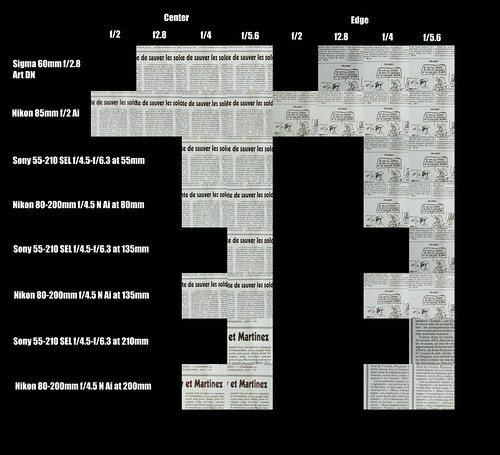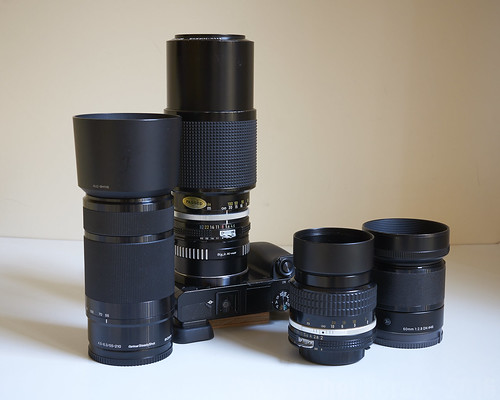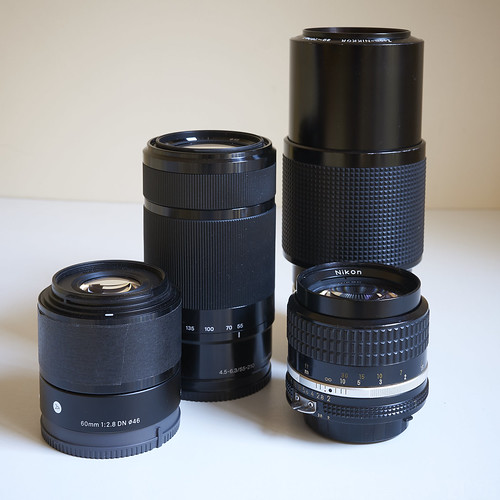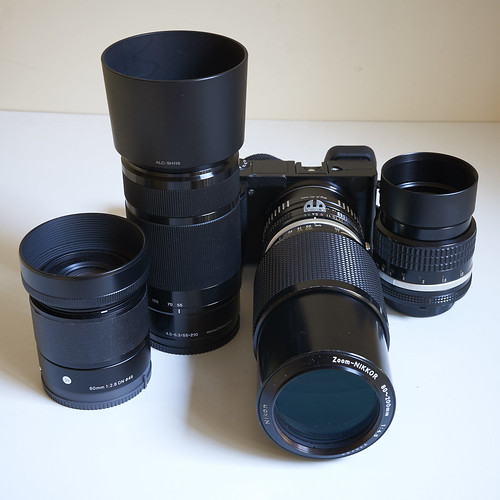Before I sell the Nikon 80-200 f/4.5 N I wanted to see how it compared to my other optics. Just in case I had a stellar lens on my hands and didn't realize it.
My by now standard comparison setup -
Here are the comparison results (be sure to look at these at 100% over on Flickr)

My by now standard comparison setup -
- Sony A6000, "A" mode, ISO100, 2 second delay trigger, very sturdy tripod
- Sigma 60mm f/2.8 EX DN E - as the standard reference shot in AF mode
- Nikon 85mm f/2 Ai - just because, shot obviously as a manual focus lens
- Nikon 80-200mm f/4.5 N Ai - up for sale, shot obviously as a manual focus lens
- Sony 55-210 f/4.5-6.3 SEL OSS - the one the focuses correctly, shot in AF mode
Here are a few family photos -
Here are the comparison results (be sure to look at these at 100% over on Flickr)

My (rather obvious) observations include -
The Sigma 60mm Art DN is incredible from wide open and corner to corner. This is why it is my reference optic.
The Nikon 85mm f/2 Ai is outstanding from wide open and corner to corner. However the contrast is lower than the modern lenses due to spherical aberrations at wide apertures. Things clean up a stop or two down from wide open and is indistinguishable from currently designed optics. I want to keep one of the three 85mm lenses I own. All are up for sale, but I can't decide between the f/2 (more modern) and f/1.8 single or multi-coated very slightly software wide open but with nice swirly bokeh early Nikon designed optics. There's no rush as none of these have interested buyers at this point.
The Sony 55-210 f/4.5-6.3 SEL OSS that focuses correctly looks like it's OK (adequate) at 55mm and 135mm. It's not going to knock anyone's socks off, but it looks like a decently sharp optic that can get the job done. My sample looks brilliant at 210mm's, however. I can't believe it. But there you have it. A nice, cheap lens that can do what I expect it to do. This is a "keeper."
The Nikon 80-200mm f/4.5 N Ai used to be a rather expensive optic. Nikon did a lot of design work on the series and their effort is apparent in the results seen here. At 80mm and 135mm it's sharper than the new Sony 55-210mm all the way into the corners (where is looks pretty darned fine, actually). At 200mm, however, there appears to be a bit of spherical aberration (or something) that clouds the image quality. Still, for 80Euros this isn't a 1/2 bad lens. Not by a long shot.
I've learned long ago that I can very nearly match image resolution between just about any lens set by making adjustments to the luminosity curve. Rarely is a lens so bad that it's resolution would be clearly worse than a high quality modern lens. So if all a person has or if all a person can afford is something old and manual focus, there's no need to fret. No one will be able to walk up to a big print and say "well, gosh, you should've used a sharper lens." Why? Because no matter what a photographer uses, it's always Always ALWAYS the mind, the creativity, and concepts of a photographer that viewers (even "educated" fellow photographers) will respond to. There is not a single person on Planet Earth who can tell you what lens made what image. It simply does not "work" that way.
The Sigma 60mm Art DN is incredible from wide open and corner to corner. This is why it is my reference optic.
The Nikon 85mm f/2 Ai is outstanding from wide open and corner to corner. However the contrast is lower than the modern lenses due to spherical aberrations at wide apertures. Things clean up a stop or two down from wide open and is indistinguishable from currently designed optics. I want to keep one of the three 85mm lenses I own. All are up for sale, but I can't decide between the f/2 (more modern) and f/1.8 single or multi-coated very slightly software wide open but with nice swirly bokeh early Nikon designed optics. There's no rush as none of these have interested buyers at this point.
The Sony 55-210 f/4.5-6.3 SEL OSS that focuses correctly looks like it's OK (adequate) at 55mm and 135mm. It's not going to knock anyone's socks off, but it looks like a decently sharp optic that can get the job done. My sample looks brilliant at 210mm's, however. I can't believe it. But there you have it. A nice, cheap lens that can do what I expect it to do. This is a "keeper."
The Nikon 80-200mm f/4.5 N Ai used to be a rather expensive optic. Nikon did a lot of design work on the series and their effort is apparent in the results seen here. At 80mm and 135mm it's sharper than the new Sony 55-210mm all the way into the corners (where is looks pretty darned fine, actually). At 200mm, however, there appears to be a bit of spherical aberration (or something) that clouds the image quality. Still, for 80Euros this isn't a 1/2 bad lens. Not by a long shot.
I've learned long ago that I can very nearly match image resolution between just about any lens set by making adjustments to the luminosity curve. Rarely is a lens so bad that it's resolution would be clearly worse than a high quality modern lens. So if all a person has or if all a person can afford is something old and manual focus, there's no need to fret. No one will be able to walk up to a big print and say "well, gosh, you should've used a sharper lens." Why? Because no matter what a photographer uses, it's always Always ALWAYS the mind, the creativity, and concepts of a photographer that viewers (even "educated" fellow photographers) will respond to. There is not a single person on Planet Earth who can tell you what lens made what image. It simply does not "work" that way.



No comments:
Post a Comment